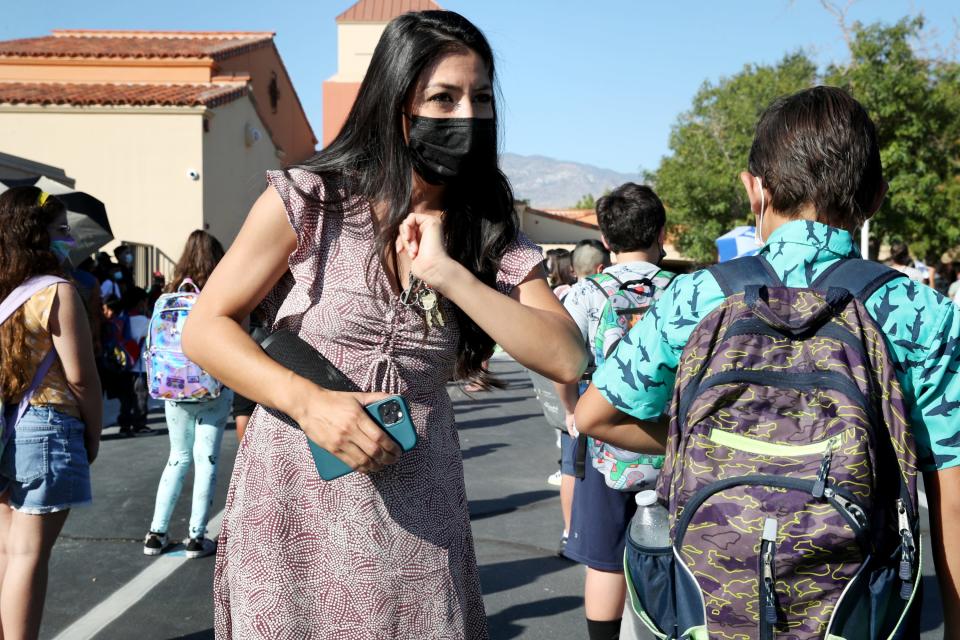Coachella Valley school districts see enrollment drops, could lose millions in funding

Enrollment at Coachella Valley K-12 public schools has declined by approximately 1,000 students since this time last year and much more than that since before the pandemic began.
Declining enrollment since 2019-20 could result in Desert Sands Unified losing approximately $13.8 million, Coachella Valley Unified losing $9 million and Palm Springs Unified losing $7.7 in state funding next school year, according to year-end reports from each of the valley’s three school districts.
K-12 funding is currently determined by average daily attendance levels set in 2019-20, but funding for the 2022-23 school year will be based on this school year's lower enrollment numbers unless policymakers change school funding formulas before then.
Average daily attendance is a function of enrollment and attendance rates, which are expected to decline this year as the average student misses more days of instruction due to COVID-19 protocols and concerns.
Declining K-12 enrollment is a statewide phenomenon that has accelerated since the COVID-19 pandemic began. The Legislative Analyst’s Office predicted in November that K-12 average daily attendance across California would decline this year by about 170,000 students (3%) relative to the pre-pandemic attendance level, and declining birth rates are the main reason for declining K-12 enrollment in California.
Some say many districts are heading toward a “fiscal cliff” as payrolls remain high and enrollments drop. For now, districts continue to receive funding based on pre-pandemic attendance levels, and local districts continue to fill vacant positions and create new ones with federal COVID-19 relief funds.
The state allocates anywhere from approximately $8,000 to more than $12,000 per student per year. These allocations may vary by school district, grade level and demographics.
Enrollment numbers key to planning
This year, Desert Sands Unified, the valley's largest school district with more than 24,000 students, receives an average of $11,646 per student, according to Jordan Aquino, assistant superintendent of business services. Next year, after a cost of living adjustment, Aquino expects the district to receive about $12,400 per student.
However, Aquino says the district’s budget might not actually increase in stride with inflation due to declining enrollment.
Aquino projects 2021-22 average daily attendance will decrease by approximately 1,157 students relative to 2019-20.
The drop in enrollment and attendance means the district could lose more than $13 million next school year if funding formulas don't change.
Such a loss would offset any budgetary gains from a cost of living adjustment, according to Aquino.
Palm Springs Unified, which serves approximately 21,000 students, reported at its board meeting last Tuesday that as of November 2021, the district had enrolled 451 students fewer than the same time last year and 605 fewer students than it projected to serve for the 2021-22 school year.
That could equate to the district receiving about $7.7 million less in state funding than it planned for and needing 22 to 25 fewer teachers, Assistant Superintendent of Business Services Brian Murray said at the board meeting.
“So you can see why enrollment is such an important component of our planning process,” Murray said.
Joe Dominguez, Aquino's and Murray’s counterpart at Coachella Valley Unified called declining enrollment a “challenge” at CVUSD's board meeting last Wednesday.
Dominguez reported that CVUSD serves 16,686 students, which is 342 fewer than it anticipated this summer and close to 700 fewer students in the district since the pandemic began.
Federal relief money is coming in
For now, California school districts are not feeling the fiscal impacts of declining enrollment and what is expected to be lower average daily attendance (ADA).
Schools were not mandated to report average daily attendance last year, and the state enacted an average daily attendance “hold harmless” provision so that districts continue to receive funding based on pre-pandemic attendance levels. That provision is set to expire at the end of this school year. Next fall, districts could receive funding based on 2021-22 attendance numbers.
Aquino said legislators continue to discuss whether they will extend the hold harmless provision another year or adjust the K-12 funding formula before the 2022-23 school year.
Dominguez added at the CVUSD board meeting: “I’m very worried about the expiration of the ADA hold harmless from the State of California."
He explained that if the average daily attendance hold harmless provision were to expire before next school year, CVUSD would lose approximately $9 million in state funding from its current budget.
On top of that, Dominguez predicted CVUSD could lose another 500 students over the next several school years.
In the short term, any fiscal blow from declining enrollment and attendance will be cushioned by federal government spending.
President Joe Biden's signature COVID-19 relief package, the American Rescue Plan of 2021, will distribute billions of dollars to K-12 school districts between now and 2024.
Through the relief package, DSUSD will receive $55.9 million by 2024, CVUSD will receive $72.8 million, and PSUSD will receive $75.2 million.
Although CVUSD and PSUSD are smaller districts, they will receive more relief plan money because they have a higher proportion of students in need, according to the California Department of Education.
Declining enrollment: a statewide issue

Declines in K-12 public school enrollment have accelerated across California since the COVID-19 pandemic began in 2020, but the California Department of Education has noticed a “modest, steady decline in public school enrollment statewide since 2014-15.”
In February 2020, just prior to the pandemic, the Public Policy Institute of California, a think tank, released a report that projected statewide enrollment would fall nearly 7% by 2027-28.
This summer, the institute said that actual declines last year exceeded pre-pandemic forecasts.
The report also said that most district-level declines in student enrollment are “large and long-lasting,” and enrollment “does not generally rebound, so most districts must adjust to lower enrollment levels.”
Where are students going?
Although declining birth rates seem to be the biggest contributor to declining enrollment, other factors could be at play, too, such as students switching to private schools or homeschooling when faced with virtual learning options; students not participating in remote learning due to lack of access to devices or internet; or, older students taking part-time jobs that conflicted with schooling, according to the Public Policy Institute of California.
Other reports have suggested that California’s declining enrollment could be related to families choosing to move out of state in search of cheaper housing. However, Riverside County's population grew by more than 200,000 residents between the 2010 and 2020 censuses.
As public school enrollment declines, the Coachella Valley’s largest private high school, Xavier College Preparatory High School in Palm Desert, has seen a 7% uptick in attendance since fall 2020.
Xavier has only 563 students, but it added 30 transfer students this fall plus a larger than average incoming class of 152 students.
“We anticipate the same kind of growth next school year as we work with the incoming freshman class (2026),” President/Principal Chris Alling wrote in an email to The Desert Sun.
Alling attributes the growth to what he calls his staff’s “seamless transition” to online instruction and learning (currently, school is back in-person), a 13:1 student-to-teacher ratio and a guarantee that every graduate will meet University of California and Cal State course completion requirements. Tuition is listed as $14,200 for the 2021-22 school year.
Approximately 42% of CVUSD, 43% of PSUSD and 58% DSUSD four-year high school graduates met UC and CSU course completion requirements in 2019-20, according to state data. Estimates vary depending on the set of data used.
What's next?
Fewer students could potentially mean fewer teachers and staff employed by local districts.
“We need to make sure that we continue to focus (to) align staffing to actual enrollment as we continue to decline,” Dominguez said, adding that the district continues to recruit for some “hard to fill” positions.
Districts across the valley continue to hire as they seek ways to spend the historic influx of federal COVID-19 relief aid that expires in 2024.
Carrie Hahnel, senior director of policy and strategy at the Opportunity Institute, an education policy research organization, warns that districts should proceed with caution as they hire more employees.
"How do you think about growing your budget and growing your staffing if you have to cut it back eventually? That's a big challenge right now," Hahnel told The Desert Sun.
She recommended that districts consider spending their federal relief package on choices that don't obligate new positions that would have to be sustained into the future.
"Districts have choices. They can choose to spend dollars that support one-time or immediate needs that don't create a fiscal cliff in the future," Hahnel said.
She added that districts would need to be creative as they go about how to do that because many districts — including local ones — are spending large portions of relief aid to hire more staff that would lower class sizes and add counselors and social workers but also obligate positions in the future. "It's really tricky because a lot of those things seem like the natural solutions, but they're also going to create longer-term fiscal risk," Hahnel said.
Unionized teachers and school staff can be laid off if a school board determines that economic circumstances require decreasing the number of permanent employees.
Each of the three local school districts is spending relief aid on a mix of COVID-19 safety protocols, investments in infrastructure and technology, professional and curriculum development, and creating new staff positions.
Earlier in the fall, the CVUSD school board questioned the district's plan to use COVID-19 relief aid to hire more staff, citing concerns about how the district would pay for those positions after 2024.
Meanwhile, PSUSD plans to use a bulk of its COVID-19 relief funds for technology improvements and facility upgrades. It also plans to use millions of dollars to expand education options including independent learning, fully virtual learning and summer school. The district intends to use some money to hire staff.
Similarly, DSUSD is using a chunk of federal relief plan money to fill dozens of positions, including additional teachers, counselors and psychologists.
Aquino told The Desert Sun his district has calculated the risk of adding positions even as enrollment declines. He said he is confident the district will be able to maintain or increase current staffing levels without laying off new hires even if inflation and lower attendance eat away at the budget.
He says the district has calculated the fiscal burdens of the positions through a process called "succession planning." Succession planning is a strategy that identifies critical positions within an organization and develops a plan to fill those positions while staying within projected budgetary constraints.
Aquino says DSUSD's succession planning accounts for much more than federal funding and enrollment and includes factors such as attrition rates, contract positions and additional funding sources.
Amid the uncertainty, Aquino says DSUSD's budget projections actually have "a lot of flexibility."
"I think we have a pretty great plan," Aquino said. "I don't know if other (districts) are thinking that far ahead... We are very cognizant about our succession and keeping people retained."
Jonathan Horwitz covers education for The Desert Sun. Reach him at jonathan.horwitz@desertsun.com or @Writes_Jonathan.
This article originally appeared on Palm Springs Desert Sun: Coachella Valley school districts see enrollment drops, may lose funds

